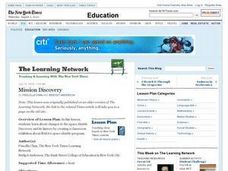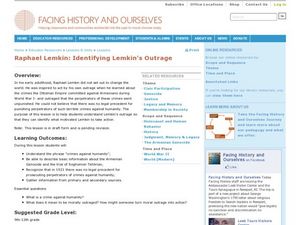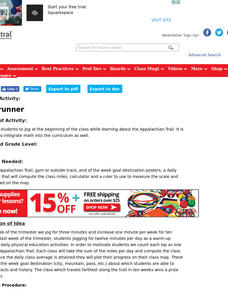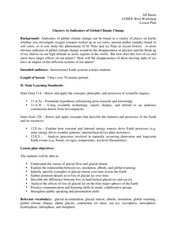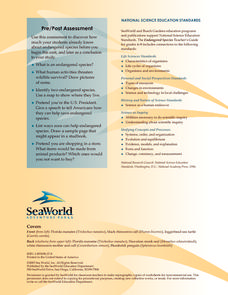Curated OER
Rhythm Nation
Students read a New York Times article to help them develop an understanding of the history, development, and social influence of various types of world music through the creation of music museum exhibits.
Curated OER
Mission Discovery
Young scholars examine the changes to the space shuttle Discovery and its history by creating a classroom exhibition about NASA's space shuttle program. They create an informative and attractive invitation about the gallery for outside...
Curated OER
Speaking in Tongues
Students examine their own family history of languages and investigate local and regional resources available to immerse themselves in a foreign language and culture. They write applications seeking an imaginary grant to fund their...
Curated OER
Nature in a Flick of the Eye
Students explore the visual information a diorama artist provides by thinking of all the details for the background of a location described by their teacher. They investigate diorama artists and their importance in creating the illusion...
Curated OER
Read On
Students consider the question "Why do we read?" through creating and sharing individual timelines of their own histories as readers. They then choose a book on which to write a personal essay.
Curated OER
A Life to Remember
Students test and discuss their ability to remember events in their recent and past history and reflect on cases of dissociative fugue and amnesia. They graph and analyze data to look for patterns in the ability to recall a list of...
Curated OER
Olympic Emblems
Students study the history of Olympic emblems. In this Olympics lesson, students examine the Olympic designs and symbols used to represent different Olympic game years. Students then collaborate to create Olympic emblems for a particular...
Facing History and Ourselves
American Responses to the Armenian Genocide
Young scholars examine World War I war crimes. In this world history instructional activity, students use primary and secondary sources to research and understand the action taken by the United States during the Armenian Genocide. Young...
Facing History and Ourselves
The Range of Choices
Learners examine crimes against human rights. In this world history instructional activity, students watch a segment of a video about the Armenian Genocide. Learners reflect on the crimes of the Ottoman government in classroom...
Facing History and Ourselves
What is Justice After Genocide?
High schoolers explore the meaning and implications of genocide. In this human rights lesson, students investigate the Aremenian genocide that took place in Turkey and the subsequent trials of the leader of the...
Curated OER
Nation Building
Ninth graders examine the role of the United States in nation building. In this World History activity, 9th graders evaluate the role of the United States in building nations in other parts of the world.
Facing History and Ourselves
Continuing Lemkin's Legacy: What Can We Do to Prevent and Stop Genocide?
Young scholars investigate genocide. In this contemporary history lesson, students research Darfur advocacy organizations and present plans of action to stop the injustice in Darfur.
Facing History and Ourselves
Raphael Lemkin: Identifying Lemkin's Outrage
Young scholars examine World War I war crimes. In this world history lesson plan, students use primary and secondary sources to research Armenian genocide and the trial of Soghomon Tehlirin.
Curated OER
Mapping the New World Lesson Plan
Students compare two maps of the same area from different time periods. In this American History lesson, students look at two maps of the English colonies from 1636 and 1651. They discuss why the maps changed and predict maps from the...
Curated OER
Puritans Lesson Plan
Students determine if the Puritans were selfish or selfless. In this American history lesson, students read two Puritans documents, answer guiding questions on a worksheet, and use evidence from the documents to write whether the...
Virginia Department of Education
Mendelian Genetics
How did Mendel know which pea plants would demonstrate certain characteristics? Pupils explore the answer this question, among others, as they complete Punnet squares, research dominant and recessive traits, and explore hereditary...
C-SPAN
Evaluating Historical Presidential Campaign Ads
Political ads flood the airwaves each election cycle. An activity including more than a dozen political ads from iconic presidential campaigns helps learners unpack how the sausage gets made during election "silly season." Using the...
PBS
A Veterans Day Thank You Note
This Veterans Day inspire scholars to say thank you to a veteran. Here, learners discover key details about a specific war using an interactive timeline, and then write a thank you letter offering their gratitude to someone who risked...
Curated OER
Ridgerunner
Students jog for three minutes at the beginning of the class, increasing one minute per week for ten weeks. They count each lap as one mile on the Appalachian Trail, computing the class average and plotting their progress on a class map.
Curated OER
Pump it Up
Young scholars explore the rising cost of gasoline and how it impacts people around the world differently.
Curated OER
Time's Up
Students reflect on the events of the year 2000 by creating timelines that note memorable events in the news and in their won private lives. They combine individual timelines into a larger classroom timeline.
Curated OER
Glaciers As Indicators of Global Climate Change
Students research about glacial ice melting on the four major spheres of the Earth. For this earth science lesson, students explain how this process relates to global warming. They create a presentation and share their findings with the...
Curated OER
Endangered species
Students define the following words: extinction, endangered species, meteorite collision, glaciation and climate warming. They investigate that there are 307 species on the endangered list, and an average of 10-20 species are added each...
Curated OER
People, Places, and Things
Students review art history in the Memphis Brooks Museum of Art. In this art history lesson, students discuss art vocabulary emphasizing landscape, portrait, and still life. They visit the museum and create their own pictures.
Other popular searches
- Us History Warm Ups
- World History Warm Ups
- U.s. History Warm Ups
- "Warm Ups" for Us History
- Warm Ups for Us History

